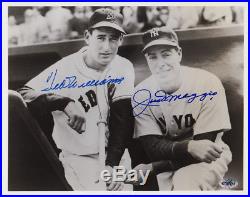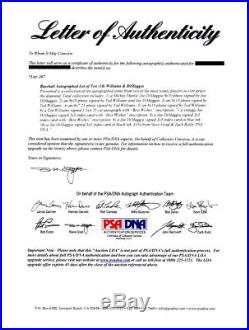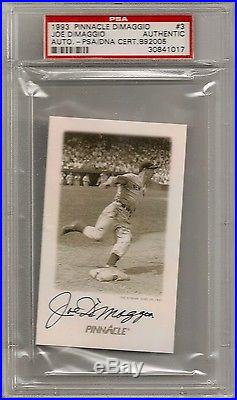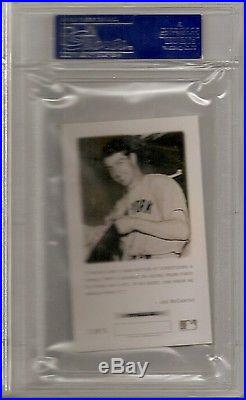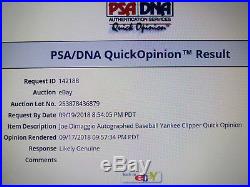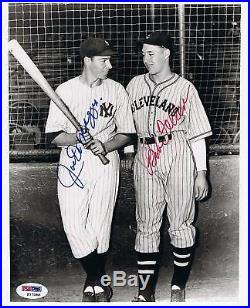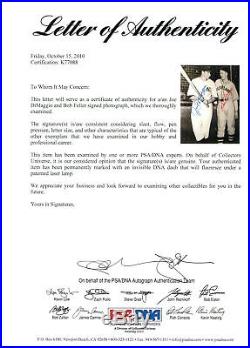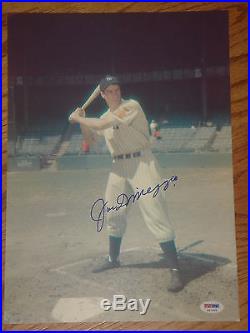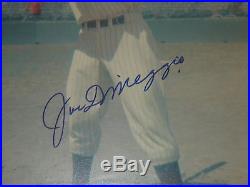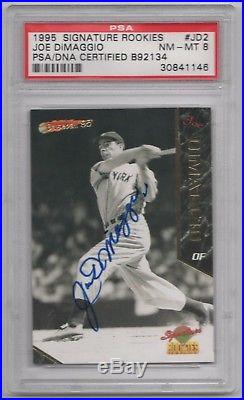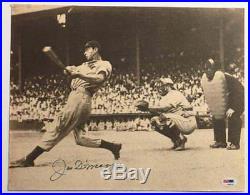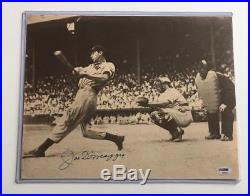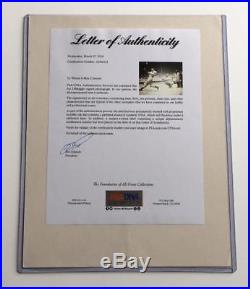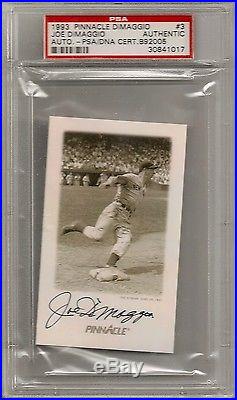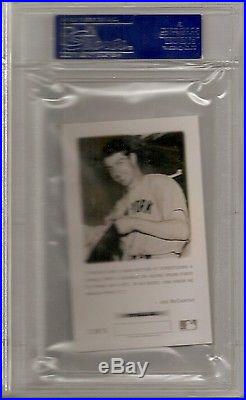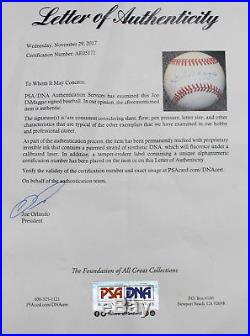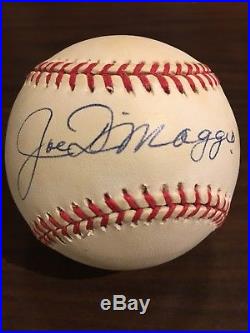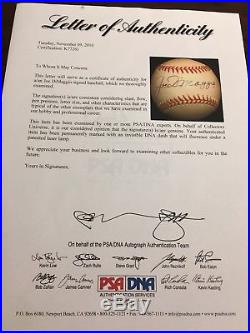From Wikipedia, the free encyclopedia. Born: November 25, 1914. Died: March 8, 1999 (aged 84) Hollywood, Florida. May 3, 1936 for the New York Yankees. September 30, 1951 for the New York Yankees. Career highlights and awards. MLB record 56 consecutive games with a hit. New York Yankees #5. Major League Baseball All-Century Team. Member of the National. Baseball Hall of Fame. 88.84% (third ballot: first eligible in 1953). Joseph Paul “Joe” DiMaggio (November 25, 1914 March 8, 1999) was an American baseball player for the New York Yankees. He was voted into the Baseball Hall of Fame. He was the middle of three brothers who each became major league center fielders, the others being Vince. DiMaggio was a 3-time MVP. Winner and 13-time All-Star. (the only player to be selected for the All-Star Game in every season he played). In his thirteen year career, the Yankees won ten pennants and nine world championships. At the time of his retirement, he had the fifth-most career home runs. (361) and sixth-highest slugging percentage. He is perhaps best known for his 56-game hitting streak. (May 15July 16, 1941), a record that still stands. A 1969 poll conducted to coincide with the centennial of professional baseball voted him the sport’s greatest living player. DiMaggio was born in. The eighth of nine children born to immigrants from Italy, Giuseppe (18721949) and Rosalia (Mercurio) DiMaggio (18781951). He was delivered by a midwife. Identified on his birth certificate. He was named after his father; “Paolo” was in honor of Giuseppe’s favorite saint, Saint Paul. The family moved to San Francisco, California when Joe was one year old. Giuseppe was a fisherman. As were generations of DiMaggios before him. DiMaggio’s brother, Tom, told biographer Maury Allen. That Rosalia’s father, also a fisherman, wrote to her that Giuseppe could earn a better living in California than in their native Isola delle Femmine. After being processed on Ellis Island. He worked his way across America, eventually settling near Rosalia’s father in Pittsburg, California. It was Giuseppe’s hope that his five sons would become fishermen. DiMaggio recalled that he would do anything to get out of cleaning his father’s boat, as the smell of dead fish nauseated him. Giuseppe called him “lazy” and “good for nothing”. DiMaggio was playing semi-pro ball when older brother Vince DiMaggio. Playing for the San Francisco Seals. Talked his manager into letting DiMaggio fill in at shortstop. He made his professional debut on October 1, 1932. From May 27 July 25, 1933, he got at least one hit. In a PCL-record 61 consecutive games. Baseball didn’t really get into my blood until I knocked off that hitting streak. Getting a daily hit became more important to me than eating, drinking or sleeping. In 1934, his career almost ended. Going to his sister’s house for dinner, he tore the ligaments. In his left knee while stepping out of a jitney. Scout Bill Essick of the New York Yankees, was convinced the Joe could overcome his knee injury and pestered the club to give DiMaggio another look. 398 with 154 RBIs. And 34 HRs, led the Seals to the 1935 PCL title, and was named the League’s Most Valuable Player. Joe DiMaggio’s number 5 was retired by the New York Yankees. DiMaggio made his major league debut on May 3, 1936, batting ahead of. The Yankees had not been to the World Series. But they won the next four Fall Classics. In total, DiMaggio led the Yankees to nine titles in 13 years. In its September 1949 issue that DiMaggio covered so much ground in center field that the only way to get a hit against the Yankees was to hit’em where Joe wasn’t. DiMaggio also stole home five times in his career. Through May 2009 DiMaggio was tied for third all-time with Mark McGwire. In home runs over his first two calendar years in the major leagues (77), behind Phillies. (83) and Milwaukee Brewers. DiMaggio was nicknamed the “Yankee Clipper” by Yankee’s stadium announcer Arch McDonald in 1939 when he likened DiMaggio’s speed and range in the outfield to the then new Pan American airliner. After a poor 1951 season, a scouting report by the Brooklyn Dodgers. That was turned over to the New York Giants. And leaked to the press, and various injuries, DiMaggio announced his retirement on December 11, 1951. When remarking on his retirement to the Sporting News on December 19, 1951, he said. I feel like I have reached the stage where I can no longer produce for my club, my manager, and my teammates. I had a poor year, but even if I had hit. 350, this would have been my last year. I was full of aches and pains and it had become a chore for me to play. When baseball is no longer fun, it’s no longer a game, and so, I’ve played my last game. DiMaggio’s plaque at the Baseball Hall of Fame. He became eligible for the Baseball Hall of Fame. DiMaggio told Baseball Digest. In 1963 that the Brooklyn Dodgers. Had offered him their managerial job in 1953, but he turned it down. He was not elected to the Hall until 1955; the rules were revised in the interim, with DiMaggio and Ted Lyons. Excepted, extending the waiting period from one year to five. He might have had better power-hitting statistics had his home park not been Yankee Stadium. As “The House That Ruth Built”, its nearby right field favored the Babe’s left-handed power. For right-handed hitters, its deep left and center fields were almost impossible to get a home run: Mickey Mantle. Recalled that he and Whitey Ford. Witnessed many blasts that DiMaggio hit that would have been home runs anywhere else, but, at the Stadium, were merely long outs (Ruth himself fell victim to that problem, as he also hit many long fly outs to center). Calculated that DiMaggio lost more home runs due to his home park than any other player in history. Left-center field went as far back as 457 ft, compared to ballparks today where left-center rarely reaches 380 ft. A perfect illustration of this is the famous Al Gionfriddo. S catch in the 1947 World Series. Which was close to the 415 foot mark in left-center. Had it happened in the Yankees current ballpark, it would have been well into the seats for a home run. To illustrate, DiMaggio hit 148 home runs in 3,360 at-bats at home, and in contrast, he hit 213 home runs in 3,461 at-bats on the road. His slugging percentage at home was. 546, and on the road, it was. Expert statistician, Bill Jenkinson, made a statement on these statistics. For example, Joe DiMaggio was acutely handicapped by playing at Yankee Stadium. Every time he batted in his home field during his entire career, he did so knowing that it was physically impossible for him to hit a home run to the half of the field directly in front of him. If you look at a baseball field from foul line to foul line, it has a 90-degree radius. From the power alley in left center field (430 in Joe’s time) to the fence in deep right center field (407 ft), it is 45-degrees. And Joe DiMaggio never hit a single home run over the fences at Yankee Stadium in that 45-degree graveyard. It was just too far. Joe was plenty strong; he routinely hit balls in the 425-foot range. But that just wasn’t good enough in cavernous Yankee Stadium. Like Ruth, he benefited from a few easy homers each season due to the short foul line distances. But he lost many more than he gained by constantly hitting long fly outs toward center field. Whereas most sluggers perform better on their home fields, DiMaggio hit only 41 percent of his career home runs in the Bronx. He hit 148 homers at Yankee Stadium. If he had hit the same exact pattern of batted balls with a typical modern stadium as his home, he would have belted about 225 homers during his home field career. In 1947, Boston Red Sox owner Tom Yawkey. And Yankees GM Larry MacPhail. Verbally agreed to trade DiMaggio for Ted Williams. But MacPhail refused to include Yogi Berra. DiMaggio enlisted in the. United States Army Air Forces. On February 17, 1943, rising to the rank of sergeant. He was stationed at Santa Ana, California. As a physical education instructor. He was discharged in September 1945. Giuseppe and Rosalia DiMaggio were among the thousands of German, Japanese and Italian immigrants classified as “enemy aliens” by the government after Pearl Harbor. Was bombed by Japan. They had to carry photo ID booklets at all times, and were not allowed to travel outside a five mile radius from their home without a permit. Giuseppe was barred from the San Francisco Bay. Where he had fished for decades, and his boat was seized. Rosalia became an American citizen in 1944; Giuseppe in 1945. In January 1937, DiMaggio met actress. On the set of Manhattan Merry Go-Round , in which he had a minor role and she was an extra. They married at San Francisco’s St. Peter and Paul Church. On November 19, 1939, as 20,000 well-wishers jammed the streets. Their son, Joseph Paul DiMaggio III was born at Doctors Hospital. On October 23, 1941. Joe DiMaggio and Marilyn Monroe staying at Imperial Hotel in Tokyo on their honeymoon. According to her autobiography, Marilyn Monroe. Originally did not want to meet DiMaggio, fearing he was a stereotypical arrogant athlete. At San Francisco City Hall. On January 14, 1954. DiMaggio biographer Richard Ben Cramer. Asserts that their marriage was filled with “violence”. One typical forceful incident occurred immediately after the skirt-blowing scene in The Seven Year Itch. Which was filmed on September 14, 1954 in front of New York’s Trans-Lux. Then- 20th Century Fox. Correspondent Bill Kobrin told the Palm Springs Desert Sun that it was Billy Wilder. S idea to turn the shoot into a media circus. The couple then had a “yelling battle” in the theater lobby. She filed for divorce on grounds of mental cruelty. 274 days after the wedding. On August 1, 1956 International News wire photo. Of DiMaggio with Lee Meriwether. Speculated that the couple was engaged, but Cramer wrote that it was a rumor started by Walter Winchell. Monroe biographer Donald Spoto. Wrote that DiMaggio was “very close to marrying” 1957 Miss America. Who won the crown with a Marilyn Monroe act, but McKnight denied it. He was also linked to Liz Renay. During this period, and to Elizabeth Ray. Years later, but he never publicly confirmed any involvement with any woman. DiMaggio re-entered Monroe’s life as her marriage to Arthur Miller. On February 10, 1961, he secured her release from Payne Whitney Psychiatric Clinic. She joined him in Florida where he was a batting coach for the Yankees. Their “just friends” claim did not stop remarriage rumors from flying. Reporters staked out her apartment building. Nominee The Second Time Around. To them at the 33rd Academy Awards. According to Maury Allen. DiMaggio’s son, Joe Jr. Was deemed a probable suicide but has been the subject of endless conspiracy theories. Devastated, he claimed her body and arranged her funeral, barring Hollywood’s elite. He had a half-dozen red roses delivered 3 times a week to her crypt for 20 years. Unlike her other two husbands or others who knew her (or claimed to), he refused to talk about her publicly or otherwise exploit their relationship. He never married again. In the 1970s, DiMaggio was a spokesman for. Becoming the face for Mr. Coffee electric coffee makers for over 20 years. Also in the 1970s DiMaggio had a 20-year run as spokesman for The Bowery Savings Bank. DiMaggio, a heavy cigarette smoker throughout his life, was admitted to Memorial Regional Hospital in Hollywood, Florida. On October 12, 1998, for lung cancer surgery and remained there for the next 99 days. On March 11, 1999, DiMaggio’s funeral was held at Sts. Peter and Paul Roman Catholic Church. DiMaggio’s son died that August at age 57. DiMaggio is interred at Holy Cross Cemetery. At his death in 1999. The New York Times. Called DiMaggio’s 56-game hitting streak in 1941, “perhaps the most enduring record in sports”. During the hitting streak, DiMaggio had a batting average of. 408, 15 home runs, and 55 runs batted in. After the streak ended, DiMaggio began a 16-game hitting streak. DiMaggio would hit safely in 72 of 73 games, another record. In an article in 1976 in Esquire. Magazine, sportswriter Harry Stein published an “All Time All-Star Argument Starter, ” consisting of five ethnic baseball teams. Joe DiMaggio was the center fielder on Stein’s Italian team. S fifth monument was dedicated to DiMaggio on April 25, 1999, and the West Side Highway. Was officially renamed in his honor. The Yankees wore DiMaggio’s number 5 on the left sleeves of their uniforms for the 1999 season. He is ranked #11 on The Sporting News. List of the 100 Greatest Baseball Players, and was elected by fans to the Major League Baseball All-Century Team. Highlights included: the ball hit to break Wee Willie Keeler. He was pictured with his son on the cover of the inaugural issue of SPORT magazine in September, 1946. In addition to his number 5 being retired by the New York Yankees. DiMaggio’s number is also retired by the Florida Marlins. Who retired it in honor of their first team president, Carl Barger. Who died 5 months before the team took the field for the first time in 1993. DiMaggio had been his favorite player. DiMaggio and Ronald Reagan. At the White House, 1981. DiMaggio’s popularity during his career was such that he was references in film, television, literature, art, and music both during his career and decades after he retired. Born: November 3, 1918. July 19, 1936 for the Cleveland Indians. September 30, 1956 for the Cleveland Indians. 1951 AL TSN Pitcher of the Year. 93.8% (first ballot). Robert William Andrew “Bob” Feller born November 3, 1918 in Van Meter, Iowa. , nicknamed the “Heater from Van Meter” , “Bullet Bob” and “Rapid Robert” , is an American. Former Major League Baseball. He was inducted into the Baseball Hall of Fame. In 1962, and is currently the longest tenured living Hall of Famer. Feller was born and raised in the small town of Van Meter, Iowa, the first child of Bill and Lena Feller. His father was a baseball fan who ran the family farm. And his mother was a registered nurse. A healthy, active child, Feller developed an early interest in baseball, playing games of catch with his father both outside and inside the house. As an Iowa farm boy in the 1920s, much of Feller’s childhood consisted of chores. He has credited milking cows, picking corn, and baling hay with strengthening his arms and giving him the capacity to throw as hard as he did. He refers to his farm days in Iowa very fondly, saying of them, What kid wouldn’t enjoy the life I led in Iowa? Baseball and farming, and I had the best of both worlds. The Robert William Andrew Feller Farmstead. Is now on the National Register of Historic Places. The Feller family built a baseball diamond on their farm from 1931 to 1932. It was on this “field of dreams” that Bob Feller learned to play baseball. Upon completion of the ballpark, complete with a scoreboard and seats, it was named Oak View Park and became the home field for the Oakviews, the team coached and recruited by Bill Feller. Feller attended high school at Van Meter High School. Where he was one of the starting five pitchers for their baseball team. He also tried to turn his sister Marguerite, ten years his junior, into a baseball player. While she did not catch on, she did play for the girls’ high school basketball team, and was the Iowa state ping-pong champion. Feller was signed by scout Cy Slapnicka. 1 and an autographed baseball. Upon being made GM of the Indians, Slapnicka transferred Feller’s contract from Fargo-Moorhead to New Orleans to the majors without the pitcher so much as visiting either farm club, in clear violation of baseball rules. After a three-month investigation, Commissioner Kenesaw Mountain Landis. Made it clear that he did not believe what Slapnicka or Cleveland president Alva Bradley. Said, but awarded Feller to the Indians anyway, partly due to the testimony of Feller and his father, who wanted Bob to play for Cleveland. Feller joined the Cleveland Indians. Without having played in the minors. He spent his entire career of 18 years with the Indians, being one of “The Big Four” Indians pitching rotation in the 1950s, along with Bob Lemon. He ended his career with 266 victories. And 2,581 strikeouts. And led the American League. In strikeouts seven times and bases on balls eight times. His fastball was nicknamed the Van Meter Heater. He pitched three no-hit. Games and shares the major league record with 12 one-hitters. Feller was the first pitcher to win 20 or more games before the age of 21. He was elected to the Baseball Hall of Fame. His first year of eligibility. When he was 17 years of age, he struck out 17 batters; he and Kerry Wood. Are the only two players ever to strike out their age (Wood struck out 20 on May 6, 1998). On October 2, 1938. Feller set a modern major league record. Against the Detroit Tigers. Season, Feller pitched a no-hitter. Against the Chicago White Sox. With the help of a diving play on the final out by second baseman. This is the only no-hitter to be thrown on Opening Day in major league history. When asked if he threw harder than any other pitcher ever, Feller responded that at the end of his career, players who had batted against him and also against Nolan Ryan. Had said Feller threw harder than Ryan. If that was the case, Feller threw over 102 mph. There is footage of Feller being clocked by army ordinance equipment used to measure artillery shell. And hitting 98.6. However, this took place in the later years of his career, and the machine used, like most of the machines at the time, measured the speed of the ball as it crossed the plate whereas now the speed is measured as it leaves the pitcher’s hand. Feller once mentioned that he was clocked at 104 mph at Lincoln Park in Chicago. He also threw the second fastest pitch ever officially recorded. At 107.6 mph, in a game in 1946 at Griffith Stadium. When Feller retired in 1956. He held the major league record for most walks. In a career (1,764), and for most hit batsmen. He still holds the 20th century record for most walks in a season 208 in 1938. In 1943, Feller married Virginia Winther (19161981), daughter of a Wisconsin industrialist. They had three sons, Steve b. 1947, and Bruce b. He lives with his wife, Anne Feller, in Gates Mills, Ohio. A suburb of Cleveland. In 2010, he threw out the 1st pitch at the Indians 1st home spring training game at Goodyear Ballpark in Goodyear, Arizona. Robert William Andrew “Bob” Feller. Born November 3, 1918. United States of America. On December 8, 1941, Feller enlisted in the Navy. Volunteering immediately for combat service, becoming the first Major League Baseball. Player to do so following the attack on Pearl Harbor. Feller served as Gun Captain aboard the USS Alabama. And missed four seasons during his service in World War II. Being decorated with five campaign ribbons and eight battle stars. His bunk is marked on the Alabama at Battleship Memorial Park. Feller is the only Chief Petty Officer in the Baseball Hall of Fame. One year after his return to Major League action, in 1946, he registered an incredible 348 strikeouts while pitching in 48 games, starting 42 of those games. That year Feller was 26-15 with an ERA of 2.18 while pitching 36 complete games. He led the American League in strikeouts seven times and had 200 or more strikeouts five times. Feller pitched in 570 games during his career, and pitched in 40 or more games six seasons. Feller also threw three no-hit games including the only opening day no-hitter in baseball history in 1940. He had 46 shutouts during his career with 10 of those in 1946. Many baseball historians have speculated that Feller would have won perhaps 350 games with well over 3,000 strikeouts had he not joined the military. He was honored as “The greatest pitcher of his time” by the Sporting News. Throughout his career, Feller criss-crossed the country playing exhibition games in the off-season, showcasing his legendary fastball for fans in large, medium and small towns. His barnstorming tours often featured other big leaguers and/or Negro League. Stars, like Satchel Paige. In 1947, Feller announced that he would pitch in the Cuban winter league. During the off-season, but major league baseball commissioner Happy Chandler. Ruled that no major leaguer could play in Cuba during the winter. Feller’s barnstorming business savvy made him one of the wealthiest players of his time. As a result, Feller did not have to take off-season jobs to make ends meet, like many players of his era did, which allowed Feller to become a physical fitness pioneer. While other players waited until spring training to get in shape, Feller had the time to do push-ups, sit-ups, calisthenics and stretching, following a rigorous regimen. In June 2009, at the age of 90, Feller was one of the starting pitchers at the inaugural Baseball Hall of Fame Classic. Which replaces the Hall of Fame Game. At Cooperstown, New York. Wall sculpture on the Bob Feller Museum. The Bob Feller Museum opened in Van Meter, Iowa. It was designed by Feller’s son Stephen, an architect. The land was donated by Brenton Banks. The museum is made up of two rooms which contain both Feller memorabilia and items from his personal collection. In 2010, it was reported that Feller was being treated for Leukemia. Player Listed in Above Title. Autographed 8 X 10 Photo. Psa/Dna is the best known and highest regarded third party authenticator in the business. The free listing tool. The item “Joe Dimaggio Bob Feller 8X10 Photo PSA/DNA COA LOA Auto Signed Autographed” is in sale since Wednesday, December 22, 2010. This item is in the category “Sports Mem, Cards & Fan Shop\Autographs-Original\Baseball-MLB\Photos”. The seller is “jjcoins” and is located in Highland, Indiana. This item can be shipped worldwide.
- Sport: Baseball-MLB
- Autograph Type: Authentic Original
- Category: Autograph
- Product Type: Autographed Photo
- Autograph Authentication: Professional Sports (PSA/DNA)
